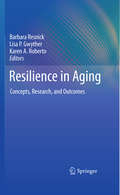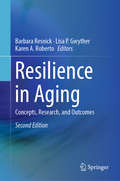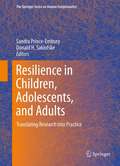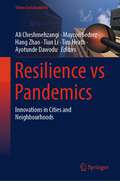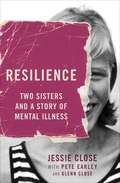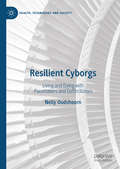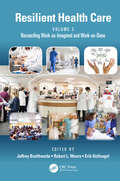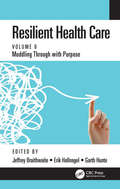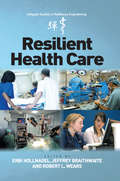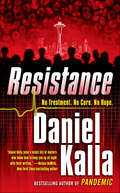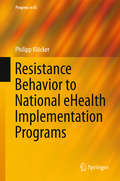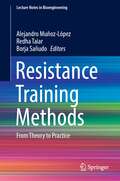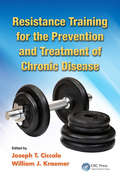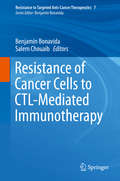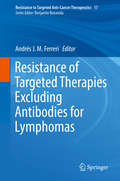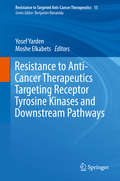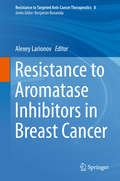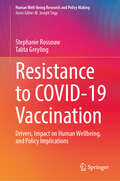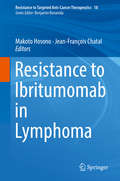- Table View
- List View
Resilience in Aging
by Karen A. Roberto Barbara Resnick Lisa P. GwytherThe many significant technological and medical advances of the 21st century cannot overcome the escalating risk posed to older adults by such stressors as pain, weakness, fatigue, depression, anxiety, memory and other cognitive deficits, hearing loss, visual impairment, isolation, marginalization, and physical and mental illness. In order to overcome these and other challenges, and to maintain as high a quality of life as possible, older adults and the professionals who treat them need to promote and develop the capacity for resilience, which is innate in all of us to some degree. The purpose of this book is to provide the current scientific theory, clinical guidelines, and real-world interventions with regard to resilience as a clinical tool. To that end, the book addresses such issues as concepts and operationalization of resilience; relevance of resilience to successful aging; impact of personality and genetics on resilience; relationship between resilience and motivation; relationship between resilience and survival; promoting resilience in long-term care; and the lifespan approach to resilience. By addressing ways in which the hypothetical and theoretical concepts of resilience can be applied in geriatric practice, Resilience in Aging provides inroads to the current knowledge and practice of resilience from the perspectives of physiology, psychology, culture, creativity, and economics. In addition, the book considers the impact of resilience on critical aspects of life for older adults such as policy issues (e.g., nursing home policies, Medicare guidelines), health and wellness, motivation, spirituality, and survival. Following these discussions, the book focuses on interventions that increase resilience. The intervention chapters include case studies and are intended to be useful at the clinical level. The book concludes with a discussion of future directions in optimizing resilience in the elderly and the importance of a lifespan approach to aging.
Resilience in Aging: Concepts, Research, and Outcomes
by Karen A. Roberto Barbara Resnick Lisa P. GwytherThis updated and expanded second edition of Resilience in Aging offers a comprehensive description of the current state of knowledge with regard to resilience from physiological (including genetic), psychological (including cognitive and creative), cultural, and economic perspectives. In addition, the book considers the impact of resilience on many critical aspects of life for older adults including policy issues, economic, cognitive and physiological challenges, spirituality, chronic illness, and motivation. The only book devoted solely to the importance and development of resilience in quality of life among older adults, Resilience in Aging, 2nd Edition continues to offer evidence-based theory, clinical guidelines, and new and updated case examples and real-world interventions so professional readers can make the best use of this powerful tool. The critical insights in this volume are concluded with a discussion of future directions on optimizing resilience and the importance of a lifespan approach to the critical component of aging. The book’s coverage extends across disciplines and domains, including: Resilience and personality disorders in older age.Cultural and ethnic perspectives on enhancing resilience in agingSustained by the sacred: religious and spiritual factors for resilience in adulthood and aging.Building resilience in persons with early-stage dementia and their care partners.Interdisciplinary geriatric mental health resilience interventions.Developing resilience in the aged and dementia care workforce.Using technology to enhance resilience among older adults. This wide-ranging and updated lifespan approach gives Resilience in Aging, 2nd Edition particular relevance to the gamut of practitioners in gerontology and geriatrics, including health psychologists, neuropsychologists, clinical psychologists, psychiatrists, social workers, geriatricians, family physicians, nurses, occupational and physical therapists, among others.
Resilience in Children, Adolescents, and Adults
by Donald H. Saklofske Sandra Prince-EmburyResilience in Children, Adolescents, and Adults: Translating Research into Practice recognizes the growing need to strengthen the links between theory, assessment, interventions, and outcomes to give resilience a stronger empirical base, resulting in more effective interventions and strength-enhancing practice. This comprehensive volume clarifies core constructs of resilience and links these definitions to effective assessment. Leading researchers and clinicians examine effective scales, questionnaires, and other evaluative tools as well as instructive studies on cultural considerations in resilience, resilience in the context of disaster, and age-appropriate interventions. Key coverage addresses diverse approaches and applications in multiple areas across the lifespan. Among the subject areas covered are: - Perceived self-efficacy and its relationship to resilience. - Resilience and mental health promotion in the schools. - Resilience in childhood disorders. - Critical resources for recovering from stress. - Diversity, ecological, and lifespan issues in resilience. - Exploring resilience through the lens of core self-evaluation. Resilience in Children, Adolescents, and Adults is an important resource for researchers, clinicians and allied professionals, and graduate students in such fields as clinical child, school, and developmental psychology, child and adolescent psychiatry, education, counseling psychology, social work, and pediatrics.
Resilience in Papal Rome, 1656-1870: A City's Response to Crisis
by Donatella Strangio Marina FormicaThis book analyses the evolution of the city of Rome, in particular, papal Rome, from the plague of 1656 until 1870 when it became the capital of the Kingdom of Italy. The authors explore papal Rome as a resilient city that had to cope with numerous crises during this period. By focusing on a selection of different crises in Rome, the book combines cultural, political, and economic history to examine key turning points in the city’s history. The book is split into chapters exploring themes such as diplomacy and international relations, disease, environmental disasters, famine, public debt, and unravels the political, economic, and social consequences of these transformative events. All the chapters are based on untapped original sources, chiefly from the State Archive in Rome, the Vatican Archives, the Rome Municipal Archives, the École Française Library, the National Library, and the Capitoline Library.
Resilience vs Pandemics: Innovations in Cities and Neighbourhoods (Urban Sustainability)
by Ali Cheshmehzangi Ayotunde Dawodu Tim Heath Hang Zhao Maycon Sedrez Tian LiThe COVID-19 pandemic and other highly transmissible diseases outbreaks have given a new significance to the concept of “resilience”, placing it in the spotlight of built environment-related studies. New directions have emerged from expanding on adaptive planning, urban layouts, urban morphologies, spatial planning, healthy cities, etc. To enhance resilience in the post-pandemic era, various theories, practices, and hypotheses are being formulated by scholars around the world.For this book project, we invite chapter proposals that provide forefront discoveries about the built environment resilience during and after the ongoing pandemic. Historical perspectives of resilience and other highly transmissible diseases are also relevant to understanding the COVID-19 issues. The authors are encouraged to elaborate on critical exploratory, innovative, and cutting-edge research approaches, highlighting the effects of COVID-19 and other highly transmissible diseases in the design, planning, and perception of the built environment. We aim to gather scientific experiences, reviews, analyses, discussions, recommendations, and solutions in the fields of urban planning, urban design, urban management, environmental science, architecture, etc.The book aims to document resilience-related innovations and new perspectives for the built environment, how people’s interactions adapt to new realities, and which mechanisms, tools, and strategies are required for such transformations in the following two scales of the built environments:(1) City/district; research on planning, commuting and mobility, politics, urban configurations, regulations, transmission and prevention, models, top-down processes, innovation processes, etc.(2) Community/neighborhood; research on collaboration, transmission and prevention, isolation and quarantine, social aspects, accessibility to services, technologies, education, policies, and innovative solutions.The book covers a wide range of studies, including physical and non-physical studies, which may refer to the city infrastructure, green/blue spaces, housing, policy-making, health services, social and economic issues, etc. The findings and results contribute to the decision-making of governments, organizations, and institutions, as well as inspire scholars and future research for developing resilience in the post-pandemic era.
Resilience: Two Sisters and a Story of Mental Illness
by Pete Earley Glenn Close Jessie CloseAt a young age, Jessie Close struggled with symptoms that would transform into severe bipolar disorder in her early twenties, but she was not properly diagnosed until the age of fifty. Jessie and her three siblings, including actress Glenn Close, spent many years in the Moral Re-Armament cult. Jessie passed her childhood in New York, Switzerland, Connecticut, Zaire (now the Democratic Republic of Congo), and finally Los Angeles, where her life quickly became unmanageable. She was just fifteen years old.Jessie's emerging mental illness led her into a life of addictions, five failed marriages, and to the brink of suicide. She fought to raise her children despite her ever worsening mental conditions and under the strain of damaged romantic relationships. Her sister Glenn and certain members of their family tried to be supportive throughout the ups and downs, and Glenn's vignettes in RESILIENCE provide an alternate perspective on Jessie's life as it began to spiral out of control. Jessie was devastated to discover that mental illness was passed on to her son Calen, but getting him help at long last helped Jessie to heal as well. Eleven years later, Jessie is a productive member of society and a supportive daughter, mother, sister, and grandmother. In RESILIENCE, Jessie dives into the dark and dangerous shadows of mental illness without shying away from its horror and turmoil. With New York Times bestselling author and Pulitzer Prize finalist Pete Earley, she tells of finally discovering the treatment she needs and, with the encouragement of her sister and others, the emotional fortitude to bring herself back from the edge.
Resilient Children: Nurturing Positivity and Well-Being Across Development (Springer Series on Child and Family Studies)
by Laura NaborsThis book examines resilience in childhood, focusing on positive functioning and development, often in the face of everyday difficulties and adversities. It highlights critical areas in which children and their families can demonstrate resilience and attain positive social, emotional, academic, and behavioral life trajectories. The book describes key factors related to enhancing resilience for children, such as positive relationships with adults, positive school environments, and meaningful connections with others. It provides practical guidelines for promoting resilience in youth and reviews the critical nature of resilience across various situations, critical issues, and different developmental periods. It offers guidance on strategies for fostering resilience in children.Key topics featured include:Raising children to have grit and tenacity.Fostering resilience in children at school and within their families.Nurturing resilience in children with chronic illnesses and posttrauma.Resilient Children is an essential resource for researchers, professors, and graduate students as well as clinicians, therapists, and other professionals in developmental, clinical, and school psychology, family studies, public health, and social work as well as all related disciplines, including educational psychology, child and adolescent psychiatry, and pediatrics.
Resilient Cyborgs: Living and Dying with Pacemakers and Defibrillators (Health, Technology and Society)
by Nelly OudshoornThis book examines how pacemakers and defibrillators participate in transforming life and death in high-tech societies. In both popular and medical accounts, these internal devices are often portrayed as almost magical technologies. Once implanted in bodies, they do not require any ‘user’ agency. In this unique and timely book, Nelly Oudshoorn argues that any discourse or policy assuming a passive role for people living with these implants silences the fact that keeping cyborg bodies alive involves their active engagement. Pacemakers and defibrillators not only act as potentially life-saving technologies, but simultaneously transform the fragility of bodies by introducing new vulnerabilities. Oudshoorn offers a fascinating examination of what it takes to become a resilient cyborg, and in the process develops a valuable new sociology of creating ‘resilient’ cyborgs.
Resilient Health Care, Volume 3: Reconciling Work-as-Imagined and Work-as-Done (Ashgate Studies In Resilience Engineering Ser.)
by Jeffrey Braithwaite Erik Hollnagel Robert L. WearsThis book is the 3rd volume in the Resilient Health Care series. Resilient health care is a product of both the policy and managerial efforts to organize, fund and improve services, and the clinical care which is delivered directly to patients. This volume continues the lines of thought in the first two books. Where the first volume provided the rationale and basic concepts of RHC and the second teased out the everyday clinical activities which adjust and vary to create safe care, this book will look more closely at the connections between the sharp and blunt ends. Doing so will break new ground, since the systematic study in patient safety to date with few exceptions has been limited.
Resilient Health Care: Muddling Through with Purpose, Volume 6 (Ashgate Studies In Resilience Engineering Ser.)
by Jeffrey Braithwaite Erik Hollnagel Garth HunteThis book promotes an understanding of the purposeful muddling that health care workers rely on to be better able to function and operate in the multitude of complex ecosystems we call "health care". The book argues the case for the importance of recognising and understanding muddling behaviours, practices and activities in order to create resilient care. The book demonstrates how resilient health care principles can enable managers as well as those on the frontlines to work more effectively towards interdisciplinary care by gaining a deeper understanding of real-world practices that manifest in everyday clinical settings. This is done by presenting a set of case studies, theoretical chapters, and applications that relate experiences, bring forth ideas, and illustrate practical solutions. Primarily aimed at people who are directly involved in the running and improvement of health care systems, it provides practical guidance. It is also of direct interest to health care professionals in clinical and managerial positions as well as researchers.
Resilient Health Care: The Resilience Of Everyday Clinical Work (Ashgate Studies in Resilience Engineering)
by Jeffrey Braithwaite Erik HollnagelHealth care is everywhere under tremendous pressure with regard to efficiency, safety, and economic viability - to say nothing of having to meet various political agendas - and has responded by eagerly adopting techniques that have been useful in other industries, such as quality management, lean production, and high reliability. This has on the whole been met with limited success because health care as a non-trivial and multifaceted system differs significantly from most traditional industries. In order to allow health care systems to perform as expected and required, it is necessary to have concepts and methods that are able to cope with this complexity. Resilience engineering provides that capacity because its focus is on a system’s overall ability to sustain required operations under both expected and unexpected conditions rather than on individual features or qualities. Resilience engineering’s unique approach emphasises the usefulness of performance variability, and that successes and failures have the same aetiology. This book contains contributions from acknowledged international experts in health care, organisational studies and patient safety, as well as resilience engineering. Whereas current safety approaches primarily aim to reduce or eliminate the number of things that go wrong, Resilient Health Care aims to increase and improve the number of things that go right. Just as the WHO argues that health is more than the absence of illness, so does Resilient Health Care argue that safety is more than the absence of risk and accidents. This can be achieved by making use of the concrete experiences of resilience engineering, both conceptually (ways of thinking) and practically (ways of acting).
Resilient Urban Environments: Planning for Livable Cities (Cities and Nature)
by Runming YaoThis book aims to provide evidence of the impact of climate change and urbanization on cities’ urban environments thus on human health and wellbeing; and principles and methods for the improvement of the resilience of a city to extreme weather and long-term climatic changes through case studies. The book will have three themes of 1) Understanding the adverse environmental impact on human health and wellbeing; 2) analysis of adaptation and mitigation measures through modeling technologies; 3) providing best practice examples of the implementation of the proposed measures. The book will present the liveable cities including factors affecting liveability; ecological and biophilic city; economic values; health and well-being and opportunities for people. Physical and social health will be an important issue in the context of resilient cities. The widespread concerns will be addressed including physical and mental health; wellbeing in terms of building use;building surroundings and Biophilia; location in the context of sustainability and work-life balance; and spatial scale and community.
Resilienz bis ins hohe Alter - was wir von Johann Sebastian Bach lernen können: Für alle Interessierten (essentials)
by Andreas KruseDie Biografie Johann Sebastian Bachs wird unter dem Gesichtspunkt der Resilienz betrachtet: Wie ist es dem großen Komponisten gelungen, trotz zahlreicher Verluste, Rückschläge und Grenzsituationen sein außerordentliches schöpferisches Potenzial zu entfalten? Inwieweit sind Bezüge zwischen der Entwicklung in verschiedenen Lebensabschnitten und einzelnen Werken erkennbar? Lässt sich das Leben Bachs selbst als ,,Werk" interpretieren? Nach einem Überblick über psychologische Resilienzforschung werden der frühe Verlust seiner Eltern, der Tod seiner ersten Frau und die von gesundheitlichen Einschränkungen und dem Verlust der Sehfähigkeit geprägte letzte Lebensphase Johann Sebastian Bachs untersucht. Dabei wird deutlich, dass es ihm bis ans Ende seines Lebens gelungen ist, sein schöpferisches Potenzial in seinem Werk wie auch in seiner Lebensführung zu verwirklichen, wobei seiner religiösen Bindung besondere Bedeutung zukommt.
Resilienz und psychologisches Wohlbefinden junger Erwachsener fördern: SystAm - Ein systemisches und achtsamkeitsbasiertes Training
by Sarah Franziska Tran-HuuDas Buch ist ein Trainingsmanual für Praktiker*innen inkl. konzeptionellem Hintergrund, Kursinhalte und aller Praxismaterialien. Das Trainingsmanual soll die Anwendung in unterschiedlichen Kontexten unterstützen, und insbesondere die Lücke von systemisch-orientierten Interventionsprogrammen auf dem derzeitigen Markt schließen. Es greift auf achtsamkeitsbasierte Techniken zurück, die durch gezielte system-therapeutische Übungen ergänzt und erweitert werden. Das Gruppenprogramm ist stark selbsterfahrungsorientiert, nutzt aktivierende, visualisierende und kreative Techniken und Übungen, die durch psychoedukative Inputs und theoretische Anleitungen sowie durch den Austausch in der Gruppe ergänzt werden.
Resilienzförderung im Jugendalter
by Christoph Steinebach Kiaras GharabaghiResilienzförderung im Jugendalter - Praxis und Perspektiven Resilienzförderung will die Widerstandsfähigkeit stärken. Gerade für das Jugendalter ist dies wichtig. In diesem Lebensalter werden besondere Risiken deutlich, sei es bei den jungen Menschen selbst oder in ihrer Umwelt. Es gilt, die Stärken, Kompetenzen und Schutzfaktoren der Jugendlichen oder ihrer Umwelt zu unterstützen. Der nachhaltige Effekt: seelische Gesundheit und optimale Entwicklung im Jugendalter und über das Jugendalter hinaus. Fundiert: Die notwendige Theorie wird mit hohem Praxisbezug vorgestellt Die Leserinnen und Leser erhalten zunächst eine kurze, prägnante Orientierung zum Resilienzkonzept. Im Anschluss werden besondere Wege der psychologischen und pädagogischen Praxis aufgezeigt - zur Sprache kommen verschiedene Lebenslagen und Umwelten. Praxisnah: Praxisbeispiele zeigen Wege der Umsetzung auf In den Beiträgen wird exemplarisch aufgezeigt, wie resilienzorientierte Interventionen zu konzipieren sind. Insgesamt soll den Leserinnen und Lesern Mut gemacht werden, die bislang primär defizitorientierten kurativen oder korrektiven Ansätze in der Arbeit mit Jugendlichen in riskanten Lebenslagen zu überwinden - und stattdessen stärkenorientiert zu arbeiten. Ein solcher Ansatz überwindet die Grenzen fachspezifischer Interventionen. Geschrieben für Psychologen, Pädagogen, Sozialarbeiter, Kinder- und Jugendlichenpsychotherapeuten, Schulpsychologen, Berater, Lehrer, Erzieher
Resistance
by Daniel KallaNo treatment. No cure. No hopeOnce it seemed as though penicillin and other antibiotics had won humanity a lasting victory over harmful bacteria. But now hardier bugs, resistant to most common classes of antibiotics, are emerging–with potentially catastrophic consequences.When Dr. Catalina Lopez of the Center for Disease Control first receives a report of a lethal new "superbug" immune to all known antibiotics, she realizes that she has a major health crisis on her hands. An ultra-resistant form of group A strep is spreading like wildfire throughout hospitals and emergency rooms in Seattle and the Pacific Northwest. Doctors, lacking any effective way to combat the infection, can do nothing but stand by and watch their patients die, one after another.Dr. Graham Kilburn, an infectious disease specialist in Vancouver, is one such doctor. Desperate to contain the spread of the new superbug, he joins forces with Lina Lopez as they try to find some way to halt the growing epidemic.What they don't realize is that shadowy forces are conspiring to spread the disease on purpose–and they will stop at nothing to avoid exposure.At the Publisher's request, this title is being sold without Digital Rights Management Software (DRM) applied.
Resistance Behavior to National eHealth Implementation Programs
by Philipp KlöckerThis monograph discusses challenges faced during the implementation of national eHealth programs. In particular, it analyzes the causes of stakeholders' reluctance to adopt these technologies by drawing on user resistance theory and context specific variables. Taking the example of the introduction of the electronic health card (Elektronische Gesundheitskarte - eGK) technology in Germany, the book presents insights into why these programs are often lengthy, costly and have previously been met with fierce resistance from key stakeholders. It also presents a quantitative and qualitative study of individual physicians' resistance behavior towards these new eHealth technologies.
Resistance Training Methods: From Theory to Practice (Lecture Notes in Bioengineering)
by Redha Taiar Alejandro Muñoz-López Borja SañudoThis book reviews the main principles of resistance training, from basics to modern insights. It includes practical ways to develop most of the strength training methods, including monitoring and testing procedures. It merges practical tips with knowledge about the scientific background concerning program and periodization. It describes procedures for special populations, such as elderly or women.Gathering contributions by authoritative researchers and professors in the fields of sport science and biomechanics, this book provides an integrated view of strength training programming, and describes the most important biological factors associated with this type of training. The evidence-based and detailed description of each single mechanism to be trained to enhance performance is covered in depth. Thanks to its strong academic background, an being self-contained, this book offers a valuable reference guide for advanced undergraduate and graduate students in sports science, as well as an inspiring guide for sport and health researchers and professional trainers alike.
Resistance Training for the Prevention and Treatment of Chronic Disease
by William J. Kraemer Joseph T. CiccoloCurrent evidence supports the use of resistance training as an independent method to prevent, treat, and potentially reverse the impact of numerous chronic diseases. With physical inactivity one of the top risk factors for global mortality, a variety of worldwide initiatives have been launched, and resistance training is promoted by numerous organisations. An evidence-based guide, this book presents an in-depth analysis of the independent and positive effects of resistance training on the prevention, management, and treatment of many chronic conditions. Written by some of the world's leading exercise physiologists and resistance training experts, the chapters provide detailed descriptions of the benefits of resistance training for specific clinical populations, including guidelines on how to construct a tailored resistance training prescription. Chapters cover resistance training to treat cardiovascular disease, metabolic diseases, cancer, orthopedic diseases, neuromuscular disorders, and more.
Resistance of Cancer Cells to CTL-Mediated Immunotherapy
by Benjamin Bonavida Salem ChouaibThis comprehensive volume explores the latest research on the mechanisms of resistance in cancer cells to CTL-mediated immunotherapy. Chapter topics discuss cell-mediated immunity as the result of cytotoxic T-lymphocytes (CTL) directed specifically against cancer cells. In addition, the volume reviews how CTL mediate the cytotoxic activity, in large part, by the indication of apoptosis; hence, tumor cells develop anti-apoptotic mechanisms and thereby, resist CTL-induced apoptosis. In order for CTL-mediated antitumor immunotherapy to be effective, it is essential that agents directed against the resistant tumor cells sensitized cancer cells for CTL-mediated apoptosis. Examples of such agents discussed in the volume include are HDAC inhibitors, proteasome inhibitors, Bcl-2 family inhibitors, PARP, antibodies, and more.
Resistance of Targeted Therapies Excluding Antibodies for Lymphomas
by Andrés J. FerreriIn the last decade, the literature on molecular mechanisms and activated pathways in the different lymphoma categories increased exponentially, which was followed by a more diffuse and successful use of targeted therapies. In this book, expert authors revisit the most relevant aspects of these therapies, with special emphasis on molecular mechanisms and clinical effects of resistance. The knowledge of the underlying mechanisms involved in tumor resistance to target therapies is of paramount importance because they will result in a better selection of patients with sensitive disease and the establishment of suitable combinations of drugs that target different molecules and could overcome the established resistance.
Resistance to Anti-Cancer Therapeutics Targeting Receptor Tyrosine Kinases and Downstream Pathways (Resistance to Targeted Anti-Cancer Therapeutics #15)
by Yosef Yarden Moshe ElkabetsThis volume comprehensively covers the multiplicity and diversity of mechanisms underlying patient resistance to currently approved anti-cancer drugs, including tyrosine kinase inhibitors and monoclonal antibodies, blockers of growth factor receptors and their downstream pathways, which play essential functions in cancer progression. Each chapter will cover a specific group of targets and the cognate drugs, along with molecular modes of innate and evolving resistance.
Resistance to Aromatase Inhibitors in Breast Cancer
by Alexey LarionovAromatase Inhibitors (AIs) treat postmenopausal estrogen receptor positive tumours, which constitute the majority of breast cancer patients. This comprehensive volume brings together the current knowledge from different relevant areas, including molecular mechanisms and translational aspects of drug resistance in AIs. Topics covered include research, experimental , and clinical data specifically focused on AI resistance in breast cancer. The volume will include three sections. The first section covers general knowledge about aromatase inhibitors, including regulation of aromatase genes, and structure and function of aromatase protein. The second section provides the detailed mechanisms of resistance to AIs, while the third section explores prediction of resistance and potential strategies to overcome resistance. Breast cancer is the most common female cancer and AIs significantly improve treatments outcomes compatibly to previously used endocrine treatments. However 10-15% of post-operative patients develop a relapse during adjuvant treatment with AIs; about 25-50% of the patients do not respond to AIs in neo-adjuvant or metastatic setting, and the majority of metastatic patients who initially respond develop resistance within 3 years. There is an important need to understand these mechanisms of resistance in order to develop methods of preventing or overcoming the resistance to AIs, which will ensure a more successful outcome in treating breast cancer.
Resistance to COVID-19 Vaccination: Drivers, Impact on Human Wellbeing, and Policy Implications (Human Well-Being Research and Policy Making)
by Stephanie Rossouw Talita GreylingThis book presents advanced methodologies for analyzing attitudes towards the COVID-19 vaccine across 10 countries spanning both the Northern and Southern hemispheres, employing cutting-edge Big Data and Fourth Industrial Revolution (4IR) techniques. Serving as an important resource for policymakers, it addresses attitudes towards and causes of growing vaccine hesitancy —a pressing concern identified by the World Health Organization as a top 10 global health threat. Moreover, the book sheds light on key factors associated with positive vaccine attitudes, aiming to bolster vaccine uptake rates. The authors explore the role of happiness in shaping health-related decision-making, offering actionable policy recommendations for governments. By sharing best-case practices, they equip policymakers and health officials worldwide with the necessary strategies to address future pandemics effectively.
Resistance to Ibritumomab in Lymphoma (Resistance to Targeted Anti-Cancer Therapeutics #18)
by Makoto Hosono Jean-François ChatalThis volume, in discussing resistance to ibritumomab, will focus on the mechanism, hematological aspects, radiological and nuclear medicine aspects, and medical physics that deal with radiation dosimetry, and will outline future prospects for overcoming resistance and enhancing efficacy of ibritumomab.
